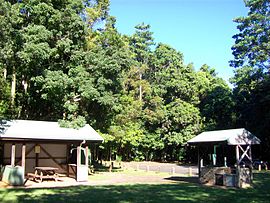
Summary
The Victoria Park Nature Reserve is a protected nature reserve that is located in the Northern Rivers region in the state of New South Wales, in eastern Australia. The sub-tropical jungle remnant is located an undulating high rainfall plain near Alstonville. The red-brown soil is derived from a basaltic flow from the nearby Mount Warning. Of the total land in the reserve, 8 hectares (20 acres) is original rainforest; and the other areas are being re-vegetated.
| Victoria Park Nature Reserve New South Wales | |
|---|---|
IUCN category IV (habitat/species management area) | |
 A picnic area located in the reserve | |
 Victoria Park Nature Reserve | |
| Nearest town or city | Alstonville |
| Coordinates | 28°54.1′S 153°24.65248′E / 28.9017°S 153.41087467°E |
| Established | April 1975[1] |
| Area | 0.18 km2 (0.1 sq mi)[1] |
| Managing authorities | NSW National Parks and Wildlife Service |
| Website | Victoria Park Nature Reserve |
| See also | Protected areas of New South Wales |
Features and location edit
The reserve is one of a few small nature reserves including the Andrew Johnston Big Scrub, Hayters Hill, Davis Scrub, Boatharbour and Wilsons Peak flora and nature reserves that conserve rainforests typical of the once extensive Big Scrub. The Big Scrub comprised 75,000 hectares (190,000 acres) of lowland subtropical rainforest which was largely cleared for agriculture in the late 19th century.[2]
Victoria Park is a popular area for picnics and barbecues. There is wheelchair access, a wooden boardwalk, pit toilets, tables, gas barbecues and information boards.
In this small area, a large diversity of flora exists. 82 tree species are included amongst the 152 plant species.[3][4] Many types of vines, smaller plants and fungi grow here. Most of the animals are nocturnal, though red-legged pademelons are sometimes seen on the edges of the grassy area. Rainforest pigeons such as the wompoo fruit dove are often heard, but rarely seen. Land mullets may be heard crawling on the rainforest floor.
Significant rainforest tree species include Moreton Bay fig, strangler fig, long jack, black bean, white booyong, red bean and bumpy ash. Other notable species include White Bean, macadamia, yellow kamala and the rare Baloghia marmorata.
A tourist attraction in the early 20th century was a giant Moreton Bay fig, around 60 metres (200 ft) tall. Allegedly sighted by Captain Cook from HMS Endeavour in 1770. The tree was damaged by a storm in 1970 and died soon afterwards.
Re-vegetation of the previously cleared farmland is under progress. However, the removal of original jungle vegetation has caused a lack of soil nutrients. Despite this, wildlife corridors are slowly being created to link other nearby rainforest remnants.
See also edit
References edit
- ^ a b "Victoria Park Nature Reserve: Park management". Office of Environment and Heritage. Government of New South Wales. Retrieved 22 September 2014.
- ^ "Victoria Park Nature Reserve: Plan of Management" (PDF). NSW National Parks and Wildlife Service (PDF). Government of New South Wales. 29 October 2013. ISBN 978-1-74359-343-1. Retrieved 21 September 2014.
- ^ Floyd, A. G. Australian Rainforests of New South Wales. Vol. 2. p. 8. ISBN 0-949324-32-9.
- ^ Victoria Park Nature Reserve - pamphlet NSW National Parks & Wildlife Service 1998
External links edit
- "Amendments to the Big Scrub Nature Reserves: Plan of management" (PDF). NSW National Parks and Wildlife Service (PDF). Government of New South Wales. July 2006. ISBN 1-74122-230-3.
- "Big Scrub Nature Reserves: Plan of management" (PDF). NSW National Parks and Wildlife Service (PDF). Government of New South Wales. December 1997. ISBN 0-7310-0894-4.


